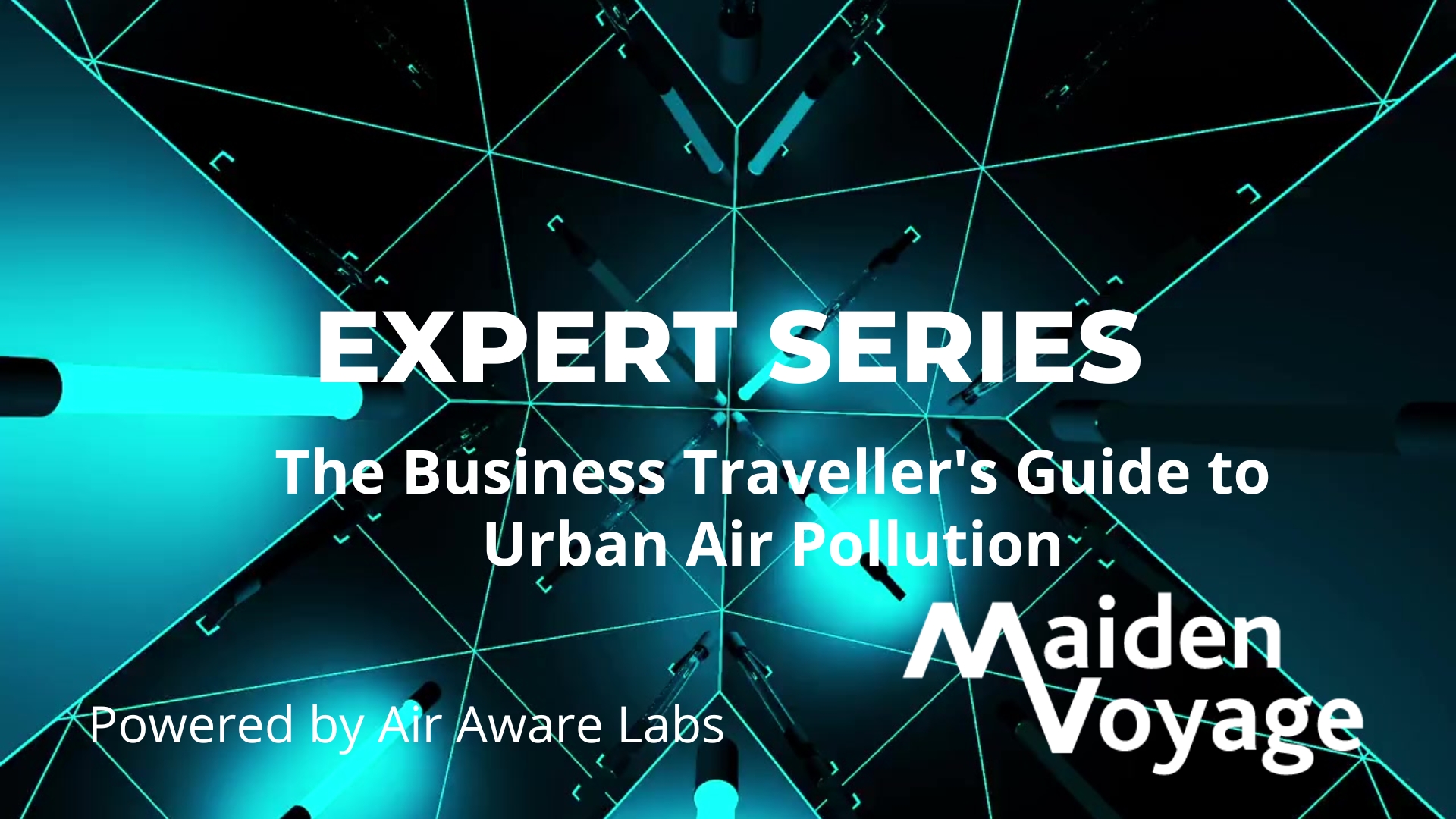
The Business Traveller’s Guide to Urban Air Pollution: Protection Strategies and Recovery Tips
When you’re travelling for business, staying active feels like an uphill battle. You walk between meetings, take the stairs instead of lifts, or power-walk to venues to rack up your daily steps. But there’s one crucial factor most travellers completely overlook: the air they’re breathing.
Business trips often take us to bustling urban centres—exactly where air pollution hits hardest. What many don’t realise is that even a short visit to a polluted city can impact your health faster than you might expect.
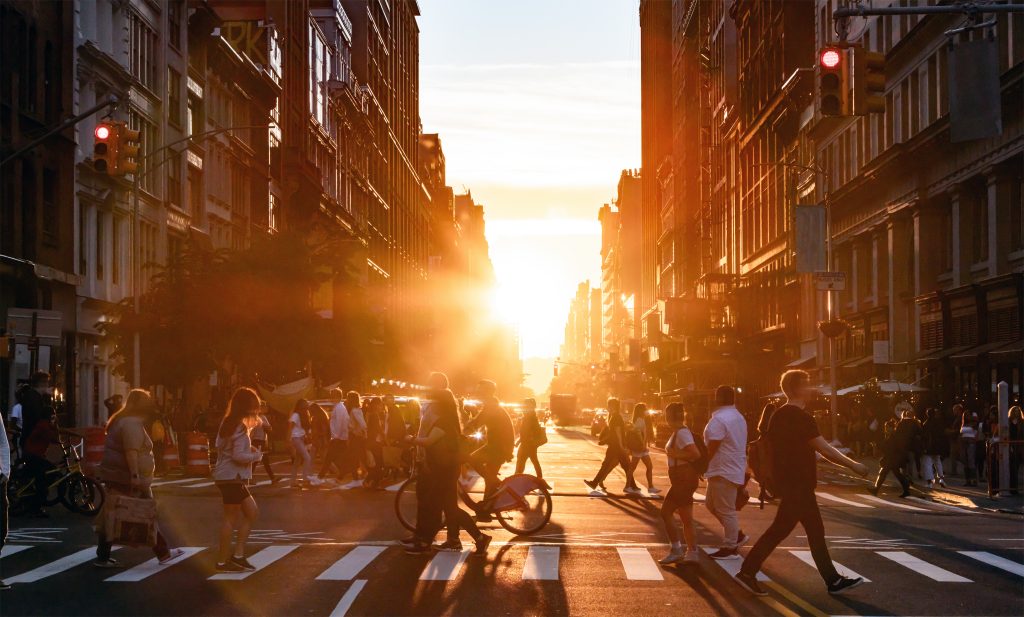
People walking through the busy intersection at 5th Avenue and 23rd Street in New York City on a summer day with sunset flare behind the background buildings. Credit:deberarr
Why Should Business Travellers Care About Air Quality?
The numbers paint a concerning picture. Air pollution is the second leading cause of death globally after high blood pressure, contributing to 8.1 million deaths annually according to the latest State of Global Air 2024 Report and costing the global economy $8 trillion according to World Bank estimates. Meanwhile, WHO data shows that 9 out of 10 people breathe air containing high levels of pollutants.
But what does this mean for your three-day business trip to Delhi or your week-long conference in Los Angeles? Research from the American Journal of Respiratory and Critical Care Medicine (2019) found that even healthy adults experienced a 6.5% drop in lung function after short visits to polluted cities. That’s not just a statistic—it’s your energy, focus, and performance taking a hit when you need them most.
Even brief exposure to high pollution can trigger respiratory discomfort, fatigue, headaches, and decreased cognitive function—exactly what you don’t need during important meetings or presentations. For employers, this means business travel impacts extend far beyond carbon footprints to include employee wellbeing, productivity, and healthcare costs.
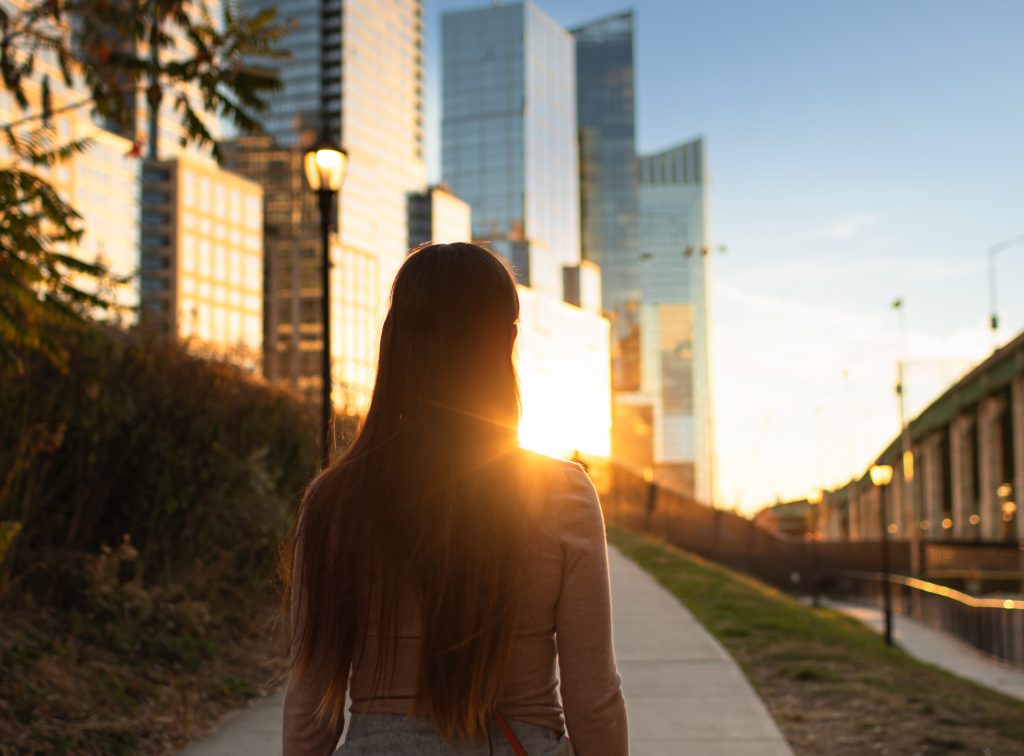
Woman in the city. Credit:kieferpix
What’s Actually in That City Air You’re Breathing?
Air pollution isn’t just the hazy skyline you see from your hotel window. We’re talking about microscopic particles that slip past your body’s natural defences and impact your system. Urban air pollution consists primarily of:
PM2.5 (Fine Particulate Matter): Microscopic particles that penetrate deep into your lungs and bloodstream, linked to cardiovascular issues and reduced energy levels. WHO guidelines recommend staying below 15 micrograms per cubic metre daily.
NO2 (Nitrogen Dioxide): A gas that causes airway inflammation and can worsen respiratory symptoms, particularly problematic near busy roads and traffic intersections. WHO recommends limiting exposure to 25 micrograms per cubic metre daily.
These pollutants are invisible but accumulate in your system with each exposure. Think of it like compound interest—small exposures add up over time, potentially impacting your health and performance.
Who Needs to Pay Extra Attention to Air Pollution?
While pollution affects everyone, certain travellers face higher risks:
- People with respiratory or cardiovascular conditions may experience immediate symptom flare-ups
- Pregnant travellers face additional risks to fetal development
- Frequent business travellers accumulate more exposure over time, compounding health risks
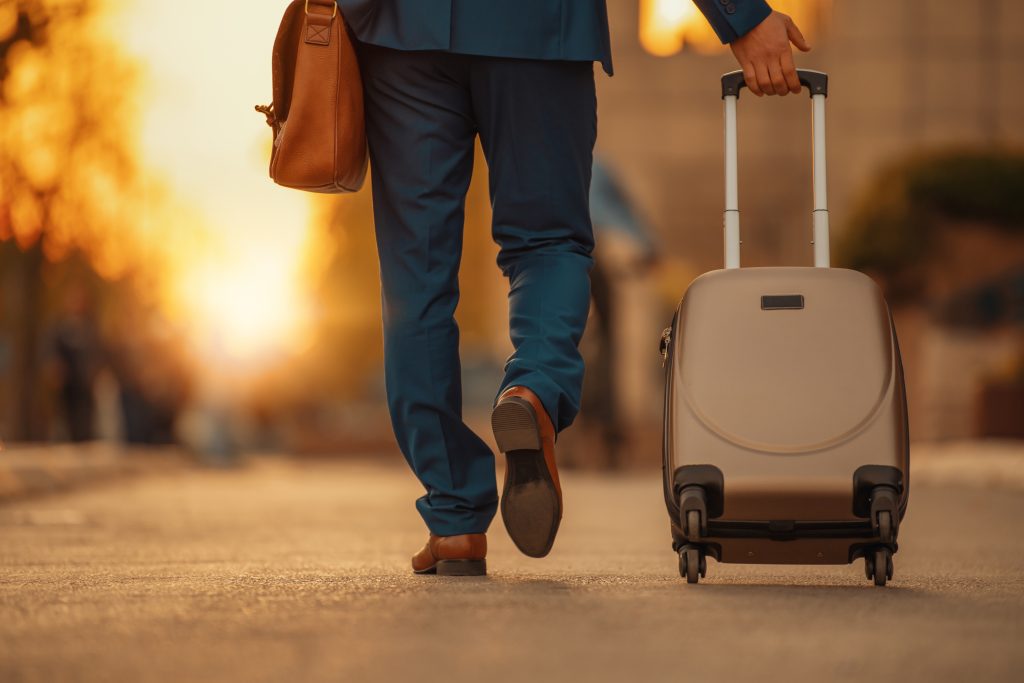
Business traveler pulling suitcase on airport.Business travel. Credit:Sanja85
How Can Business Travellers Protect Themselves from Air Pollution? Practical Protection Strategies During Your Trip
Here’s how to minimise pollution exposure while maintaining your activity levels during business travel:
Smart Route Planning
- Use air quality apps like IQAir and PurpleAir for general city-wide pollution levels, or apps like AirTrack for personalised street-level exposure during your walks to check pollution levels before stepping outside
- Avoid main roads and busy intersections when walking between venues—even a slight detour can significantly reduce exposure
- Choose tree-lined streets and parks where possible, as vegetation helps filter air pollutants
- Walk on the upwind side of streets to avoid concentrated exhaust fumes from traffic
Strategic Timing
- Schedule outdoor walking for early morning hours (typically 6-8 AM) when traffic is lighter and air is cleaner
- Avoid rush hour outdoor activities (typically 7-9 AM and 5-7 PM) when pollution peaks
- Check weather patterns—windy days help disperse pollutants, while still, humid days trap them closer to ground level
- Monitor daily air quality forecasts and plan indoor alternatives during high pollution alerts
Protective Measures
- Wear N95 or P2 masks during unavoidable high-exposure situations like walking along busy roads
- Keep exposure time short—if you must walk in polluted areas, take the most direct route
- Use indoor alternatives like hotel gyms, covered walkways, or underground passages when air quality is poor
- Close windows in taxis and hotel rooms when in heavily trafficked areas
Activity Modifications
- Opt for indoor venues for breakfast meetings or casual discussions when air quality is poor
- Use building-to-building connections like skywalks or underground passages in city centres
- Take public transport during peak pollution hours rather than walking
- Schedule phone calls indoors rather than walking outside during poor air quality periods
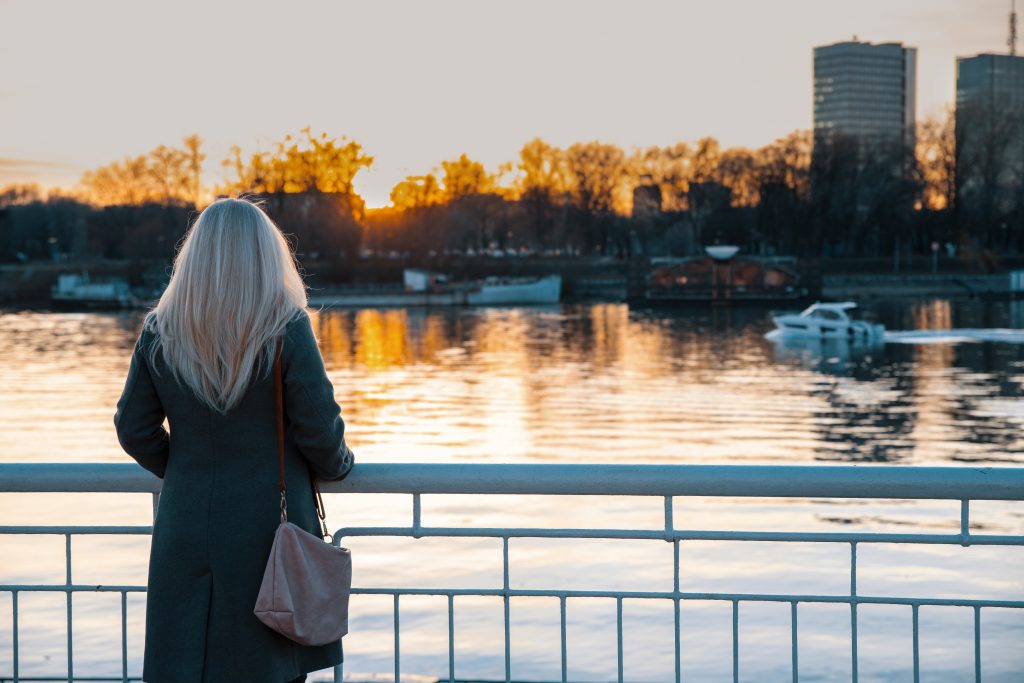
. Female standing on the bridge enjoying cityscape at evening. Credit:Biserka Stojanovic
Recovery Strategies: Helping Your Body After Air Pollution Exposure
The good news is that your body has remarkable recovery capabilities. Here are evidence-based strategies to help minimise the impact of pollution exposure once you return home:
Nature-Based Recovery
- Spend time by the sea—coastal areas typically have cleaner air, and sea breezes can help clear your respiratory system
- Take countryside hikes—research shows that time in natural environments with clean air supports respiratory recovery
- Visit parks and green spaces—even urban parks can provide cleaner air and help your lungs recover
- Plan weekend getaways to low-pollution areas after heavy business travel periods
Nutritional Support
- Increase antioxidant intake through berries, leafy greens, nuts, and citrus fruits to combat oxidative stress from pollution
- Add anti-inflammatory foods like fatty fish, turmeric, and green tea to support your body’s natural healing processes
- Stay well-hydrated to help your body’s detoxification systems function optimally
- Consider vitamin C and E supplements (consult your healthcare provider first) as these may help counter pollution damage
Physical Recovery Activities
- Practice deep breathing exercises in clean air environments to help expand lung capacity and clear pollutants
- Engage in light exercise in low-pollution areas like parks or coastal paths to promote circulation and lung function
- Try swimming in clean pools or natural bodies of water—the breathing patterns can help clear your respiratory system
- Use steam rooms or saunas (if you have no health contraindications) as heat therapy may help eliminate toxins through sweating
Lifestyle Adjustments
- Prioritise quality sleep to allow your immune system time to recover and repair
- Reduce additional pollutant exposure at home by using air purifiers and avoiding smoking or harsh chemicals
- Monitor your symptoms and consult healthcare providers if respiratory issues persist after travel
- Plan recovery time between high-pollution business trips when possible
Can You Actually Undo Air Pollution Damage?
While you cannot completely reverse pollution exposure, research suggests your body can significantly recover from short-term exposure effects. Studies show that lung function can improve within days to weeks of returning to cleaner air, particularly if you support recovery through the strategies mentioned above.
The key is consistency—regular exposure to clean air, proper nutrition, adequate hydration, and appropriate physical activity all contribute to your body’s ability to recover from and resist pollution damage.
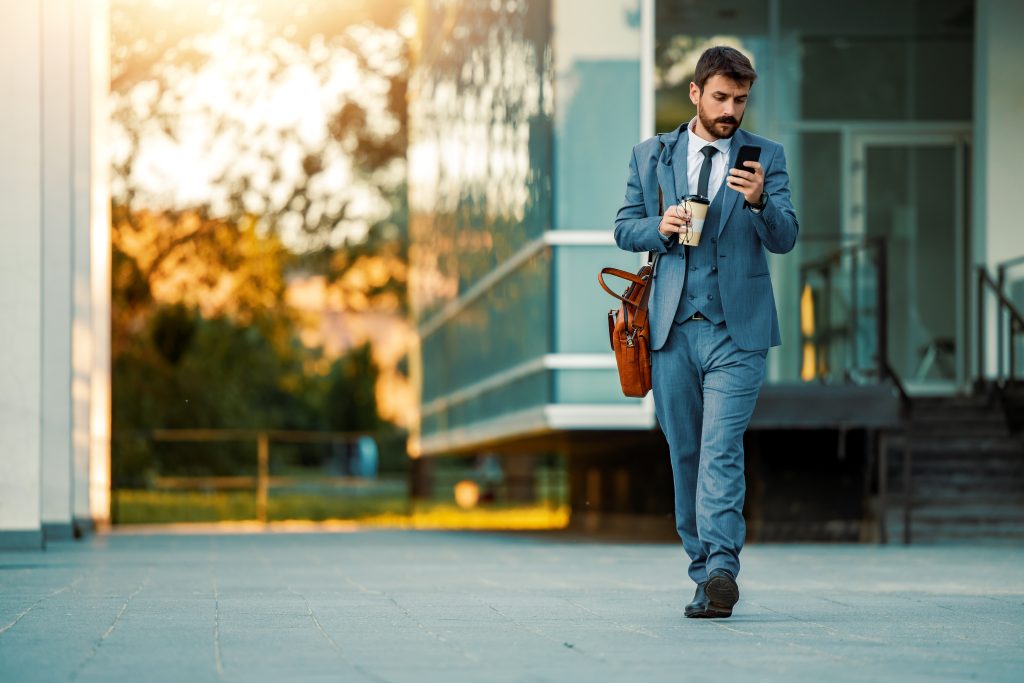
A businessman in a suit walks outside while checking his smartphone. He carries a coffee cup and a leather bag, enjoying a sunny day. Credit:Sanja85
Making Business Travel Healthier
Business travel will continue to be part of professional life, but you can significantly reduce its health impact through informed decisions. The goal isn’t to avoid all outdoor activity—it’s to be strategic about when, where, and how you stay active during your trips.
Small changes like checking air quality before that morning walk to your client meeting, choosing quieter streets for your daily steps, or scheduling recovery time in nature after returning home can make a meaningful difference to your long-term health and immediate performance.
By understanding urban air pollution patterns and taking proactive steps both during and after your travels, you can maintain your professional commitments while protecting your health—ensuring you’re performing at your best both on the road and back home.
This article was powered by Air Aware Labs. We believe clean air is essential for healthy communities and thriving businesses. We’re dedicated to helping individuals and organisations access cleaner air through practical, data-driven strategies that promote sustainability and better health for all. Our AirTrack app provides personalised air quality insights for travellers and businesses. Want to learn more? Contact us at hello@airawarelabs.com or visit www.airawarelabs.com
Find our other Expert Series blogs here.
Further Reading
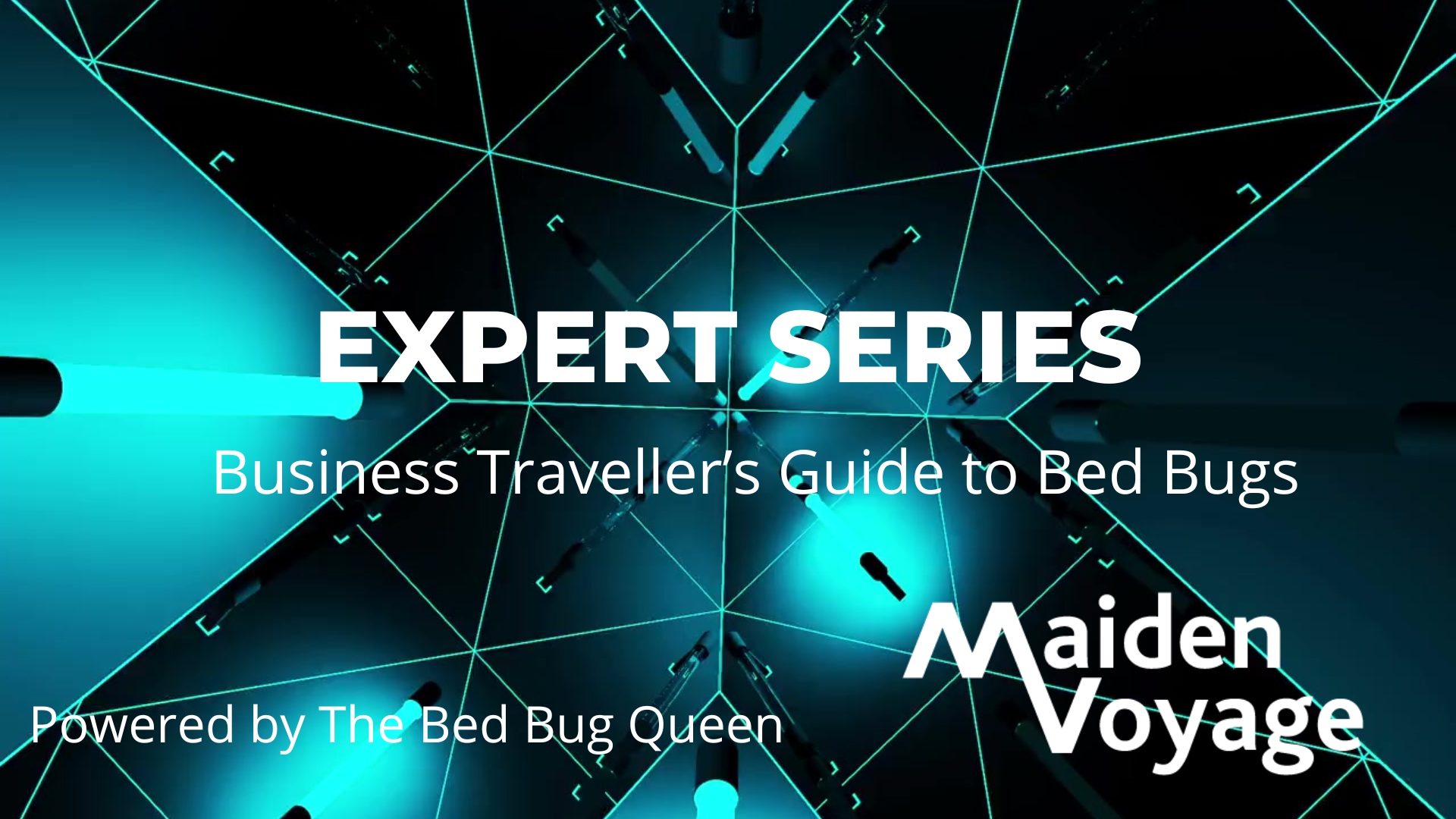
For professionals who travel frequently, maintaining health, comfort, and focus on the road is essential. One hidden disruptor that can impact both your well-being and productivity is the dreaded bed bug. These tiny pests are more than just an inconvenience — they can affect your physical health, mental well-being, and even your business performance. Importantly, no hotel is immune to bed bugs. Whether you’re staying in a budget motel or a five-star luxury property, these pests can appear anywhere because they hitchhike easily and spread quickly.
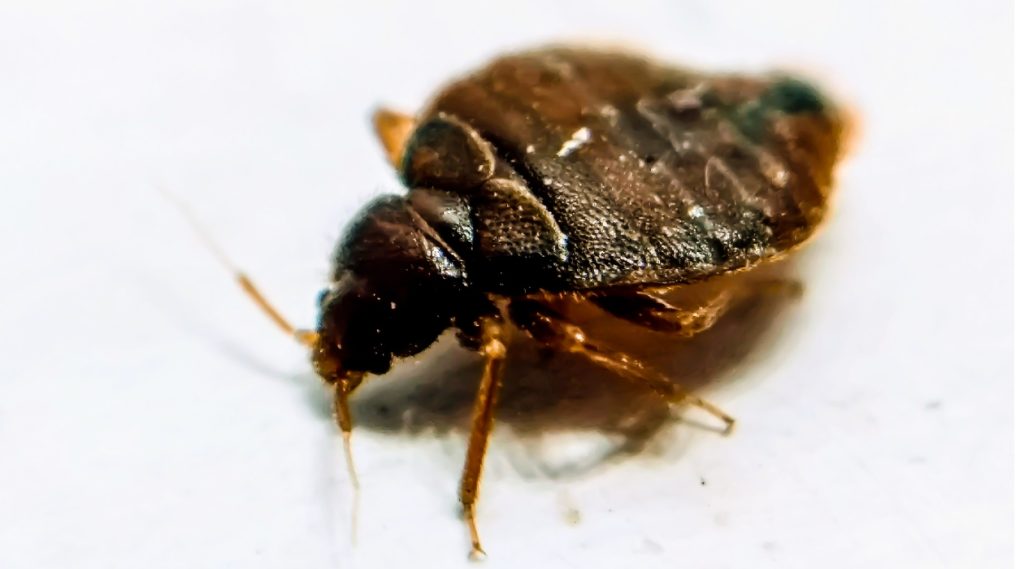
What a bed bug looks like
Understanding Bed Bugs and Their Impact
Bed bugs are small, parasitic insects that feed on human blood, often at night. While they don’t spread diseases, they can cause itchy bites, allergic reactions, and even secondary infections from scratching. Beyond the physical discomfort, many travelers experience heightened stress, anxiety, and sleep disruption after discovering an infestation. Add to that the cost and inconvenience of extermination and replacing personal items, and it’s easy to see how these pests can derail both your trip and productivity.
Where You Might Encounter Bed Bugs
Bed bugs can cross your path at many points in a trip. They may hitch a ride in airport seating areas or luggage storage compartments on planes. While less common, they can also be found in rideshares or taxis if an infested passenger was there before you. Hotels, however, remain the biggest source of exposure due to high guest turnover. Even shared workspaces or meeting venues with upholstered furniture can occasionally harbor these pests.
Checking Your Hotel Room
Before unpacking, take a few minutes to inspect your room. Pull back the sheets and look along mattress seams, headboards, and pillows for dark spots or live insects. Check upholstered chairs, couches, and even under desks. Store your luggage in the bathroom, where hard, smooth surfaces make it harder for bed bugs to hide. Avoid using the luggage rack — they’ve become a surprisingly common exposure site because so many travelers now use them.
Reducing Your Risk of Bites
Although there’s no guaranteed way to avoid bed bugs, a few habits can help minimize your risk. Storing your clothes in resealable bags inside your suitcase keeps them protected. Wearing light-colored sleepwear makes it easier to spot unwanted visitors early. And while it’s never recommended to use repellents or essential oils if you have an infestation at home, applying them in a hotel setting may help reduce the number of bites during your stay.
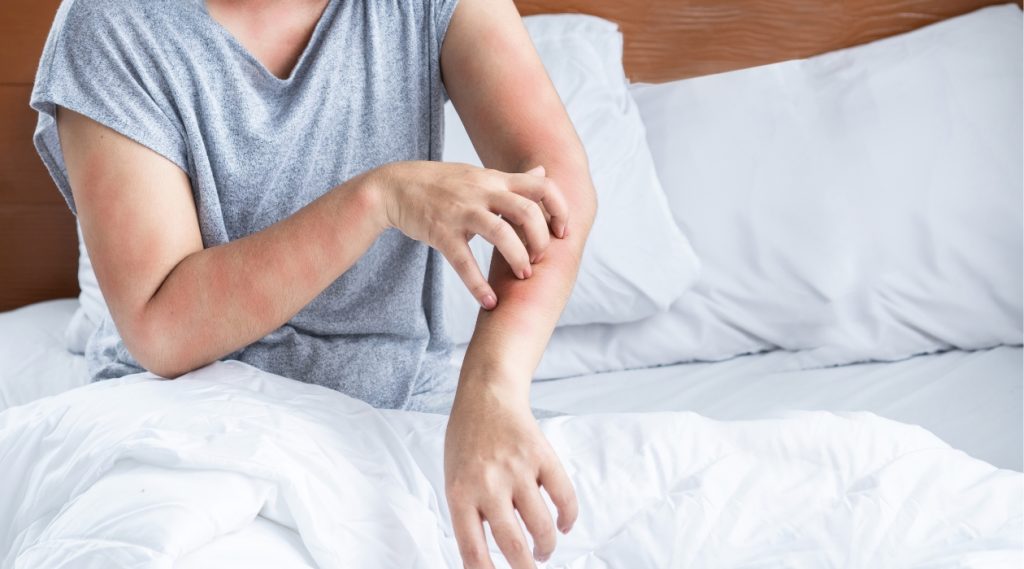
Itchy rash caused by bed bugs
If You Suspect Bed Bugs
If you wake up with unexplained bites or notice signs of bed bugs, act quickly. Report the issue to hotel management and request a new room far from the original one. However, do not move your luggage to the new room until your belongings have been thoroughly inspected and either washed at high temperatures or heat-treated. Some hotels even offer unusual but effective solutions, such as using their sauna to heat-treat suitcases — an unexpected yet surprisingly practical approach.
Keeping Them Out of Your Home
Once your trip ends, take extra precautions before bringing anything indoors. Wash and dry all clothing at high temperatures immediately. Inspect your suitcase thoroughly, paying close attention to seams and compartments. For items that can’t be laundered, consider professional cleaning to ensure they’re bug-free. There are also specialty companies that offer freezing services for luggage and belongings, eliminating bed bugs before you even bring your items back inside.
Handling a Home Infestation of Bed Bugs
If bed bugs make it into your home, don’t waste time with DIY methods. Call a professional pest control service — it’s the fastest and most reliable way to eliminate an infestation. Isolate and treat affected belongings with heat when possible, and use bed bug-proof covers to protect your mattress and pillows. Regular follow-up inspections can help ensure the problem doesn’t return.
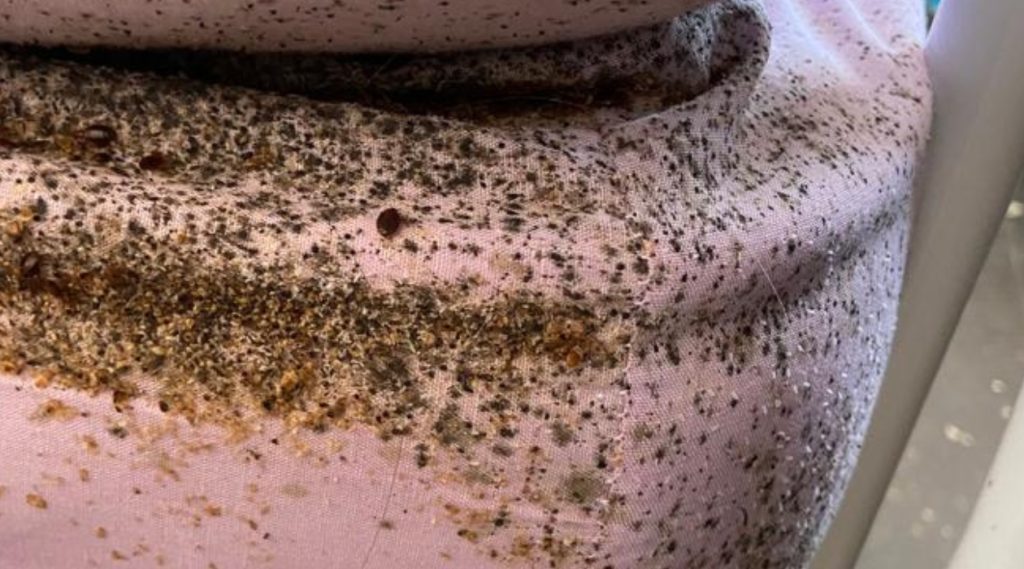
Mattress infested by bed bugs
Follow The Bed Bug Queen’s Golden Rules:
- Do not use any over-the-counter sprays, fogger bombs, or repellents. These can cause bed bugs to both hide deeper and to disperse to new areas, making an infestation harder to resolve
- Do not move any infested items unless thoroughly sealed with several layers of pallet wrap or strong rubbish bags taped shut. If you use rubbish bags, twist the top and tie one strong knot — not “bunny ears,” which don’t create a full seal.
- Do not relocate to other rooms. Bed bugs are skilled at tracking us by detecting CO₂ from our exhaled breath. They can, and will, move to other rooms to find a food source.
About the Author
This guide was written by Sarah Spratt, Director at The Bed Bug Queen Ltd. With nearly a decade of experience in the identification and treatment of bed bugs, Sarah has worked with families, travelers, and businesses across the UK, helping them tackle infestations with confidence and clarity. Known for her practical advice and calm approach, she’s passionate about removing the stigma around bed bugs and empowering people to handle situations effectively.
When she’s not inspecting rooms or advising clients, Sarah shares her expertise online to help others spot and solve problems early.
Want to know more? Check out
Further Reading
zeallite2019_ThemeView caught exception: Unable to locate template ‘partials/page/page-hotels.php’